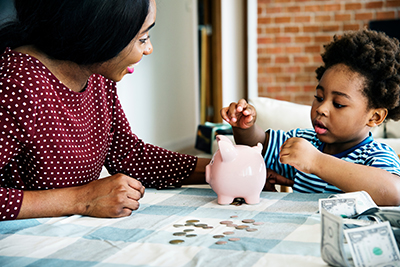Teach Your Kids About Money


How did you learn to handle money?
Many people learn about money from their parents. In fact, most young adults say they look to their parents to teach and guide them in money management (Charles Schwab 2009 Young Adults & Money Survey Findings). Good money skills are the best way to build wealth.
As parents, we can help our children learn how to build wealth.
Whether a child is two or twenty-two, we can help them learn about money.
- Preschoolers can learn to count and learn about coins.
- Elementary-age children can start to learn about banking, credit, and planning ahead.
- Older children may be interested in learning about income and career options.
- Your young-adult child may need to know about auto loans or retirement accounts.
One of the most important things we can do is to talk to children about money.
If it doesn’t come up in conversation naturally, make an effort to bring it up. Children’s understanding of money varies by age level. Preschoolers watch as we drive through at the bank, make decisions at the store, and pay at the register. Seize the moment to talk about what you’re doing.
- Teach them to count – it’s the basis of all financial exchange.
- Have age-appropriate conversations with older kids.
- Talk about how your family earns income.
- Discuss your household budget.
- Be calm and positive. Money can be a highly charged emotional topic for adults.
Three ways to start the money discussion
Here are topics to discuss around the dinner table:
- “If you found $100 what would you do with it?”
- “What are two inexpensive things our family can do for fun?”
- “If you could start your own business, what would you like to do?”
Help your kids make solid consumer decisions
Kids are at risk of believing commercials and ads and may not have the ability to make sound decisions without a parent's guidance. Consumer decisions may be small, like picking a breakfast cereal; or large, like choosing a career. Consumers, beginning at a young age, need to become aware of outside influences.
- Teach your child to think before buying.
- Preschoolers will respond to ads even though they can’t understand how they work.
- Elementary-age children can begin to understand that ads try to persuade people.
- Teens and young adults are potential victims of hard-pressure sales tactics.
- Help them to be critical of advertisements and sales pitches.
- Guide them in learning to make decisions based on facts.
Preschoolers see that money is exchanged for goods and services.
Young children learn through play. Your preschool or early-elementary child might enjoy setting up a pretend store.
Take turns being the customer or sales person. Use play money. Help your preschooler learn to make decisions by letting her choose from two options. Make sure both options are acceptable to you. For example, you might ask “Do you want toast or cereal for breakfast?” Elementary-age children can plan ahead for spending and saving. Teens can gather product information and comparison shop to find the best buy. Young adults may need you to point them in the right direction for finding the answers to complex financial decisions.
Begin early on to talk about needs versus wants.
The sooner children learn this lesson, the better. Needs are things that are critical to survival, such as food, shelter, and clothing. Wants are not necessary for health or safety. They may add fun to life but they are limitless. Unlimited wants can lead to overspending. A solid spending plan covers the family’s needs before putting money toward things family members want.
How allowances help kids learn about money
Providing an allowance is a good way to help children learn the basic concepts of budgeting, saving, and goal setting. An allowance is a specific amount of money given at a regular time. For example, you might give your 12-year old son $5.00 every week. Individuals have differing views about allowance. Some people think it’s a great idea and some are against it. Allowance can be a great teaching tool when it’s done right.
Here are a few do’s and don’ts for allowance.
Do: Give a specific amount at a regular time.
This can be weekly or monthly. The amount depends on your child’s age, your income level, and the types of things you expect your child to pay for. Will the money be pocket change? Will your teen be paying for entertainment, gasoline, and clothing? Provide guidance but also let the child have some freedom to make decisions.
Don’t: Allowance shouldn’t be used as payment, reward, or punishment.
Using allowance for reward or punishment gives the idea that everyone and everything has a price. All family members should have regular household chores that aren’t tied to payment.
“Spend, Save, and Share” is an easy way to teach basic money management.
- Spend no more than 80% of your income.
- Save at least 10% of your income.
- Share at least 10% of your income.
Your child can spend less than 80% if he wants to share or save more. Sharing can be gifts or donations to charity. Guide your child to plan ahead for spending and to set goals for saving. Teach your children about money management and put them on the path to success.